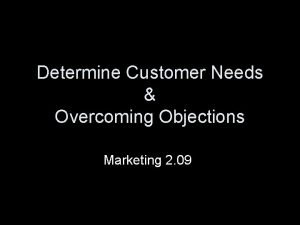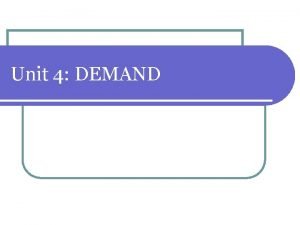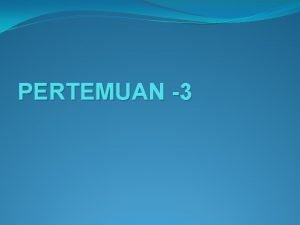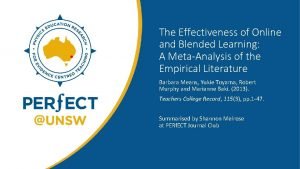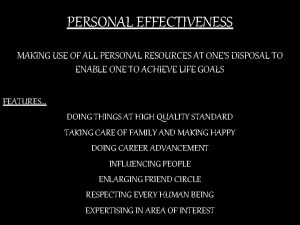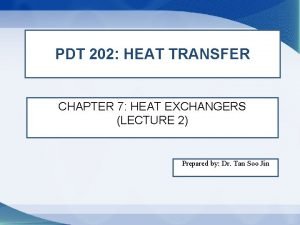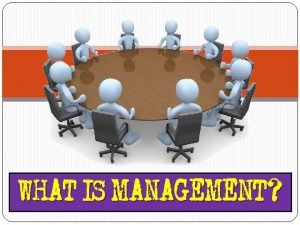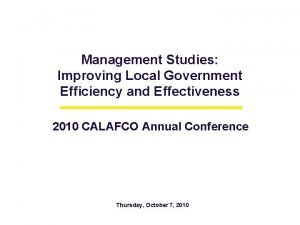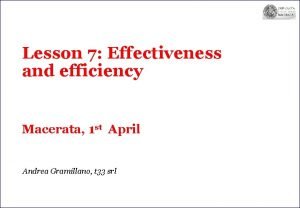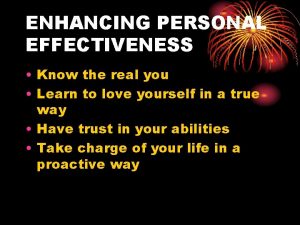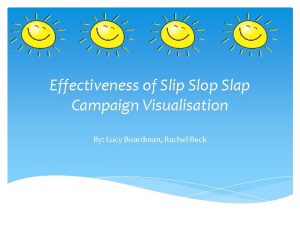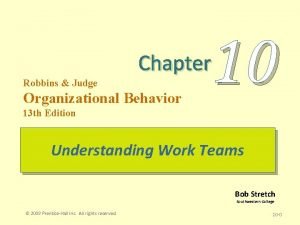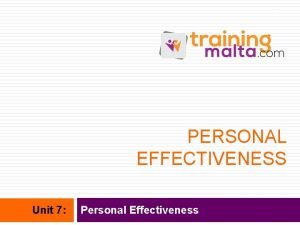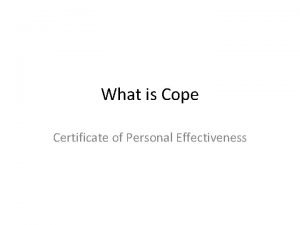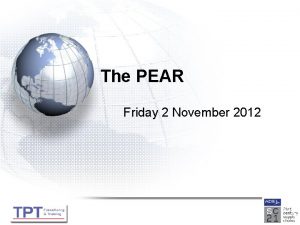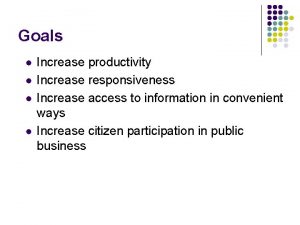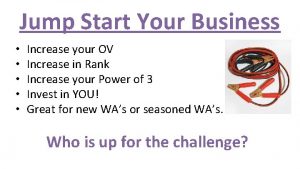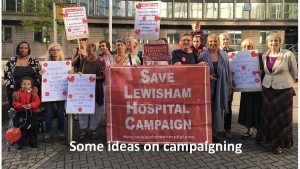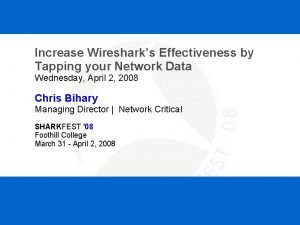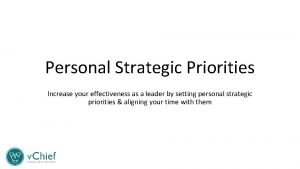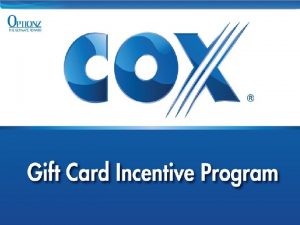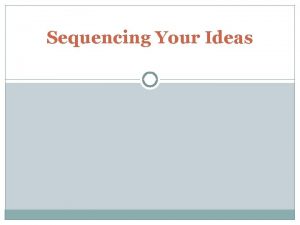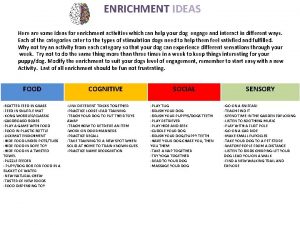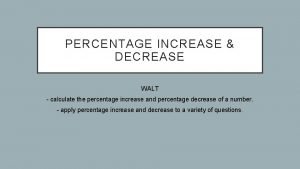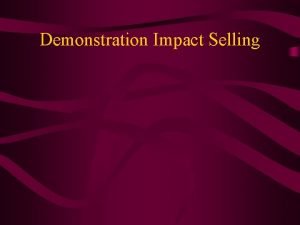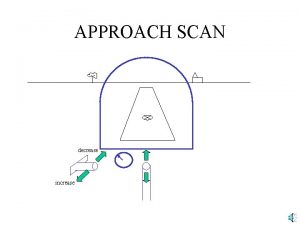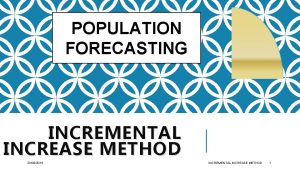MEETING METHODS SOME IDEAS TO INCREASE YOUR EFFECTIVENESS



































- Slides: 35

MEETING METHODS SOME IDEAS TO INCREASE YOUR EFFECTIVENESS WITH MEETINGS Presented by Penny Sabrosky Clinical Educator Advisor

Objectives: Upon completing this education program, the participant should be able to: § § Describe the advantage of planning before your meeting Learn effective ways to run a meeting Learn how to increase team engagement Discover how to energize team members

What brings you to this conference? 1) Knowledge Building? 2) Networking Opportunities? 3) My Boss Made Me Attend?

Interesting Summary? So why do people voluntarily attend meetings? I think there are three main reasons: They have to, in the case of the committee chair and other key committee members; They have something to contribute, as with a committee member in charge of a specific function like advancement, equipment or finance; They are looking for some way to help, even if they don’t come right out and say so.

Why do people hate meetings? People love to say they hate meetings, but what is it specifically about meetings that people loathe? § No agenda sent in advance § Early morning, during lunch, or after hour meetings § Meetings that end without a decision or next steps § Brainstorms wherein no one is assigned to take notes § Recurring useless meetings § People who 'hijack' meetings § Having to wait for one individual to show up § Meetings booked the same day § When meetings are canceled just before they start

Studies suggest that most professionals spend close to 50% of their working time in meetings

Icebreakers for Team and Staff Meetings Whether the group knows each other or it is simply a day when no one wants to be in the scheduled staff meeting, using an icebreaker game is a great way to get everyone relaxed and ready to go. icebreakerideas. com/icebreakers-for-team-staffmeetings https: //www. govloop. com

So Lets Have Some Fun With Part of That 50% RED- Name and Where You Work ORANGE-Name and How Long You Have Been in Central Service PURPLE-Name and Your Favorite Place/Assignment to Work in Central Service YELLOW-Name and Tell Us Your Favorite Food GREEN- Name and Who is Your Favorite TEAM

TOGETHER EVERYONE ACHIEVES MORE

Being Part of a Team By being part of a team, you have an opportunity to help your organization or department tap into a tremendous reservoir of talent, knowledge, and creativity. § You can learn more about your job, the people you work with, the organization you work for, the customers you serve § Your chance to learn and practice useful work skills §

4 Basic Characteristics for Healthy Teams 1. TRUST 2. MUTUAL RESPECT 3. CONSISTENT AND VISIBLE SUPPORT 4. OPEN AND HONEST COMMUNICATION

Meetings are vital for management and communication § Properly run meetings save time § Increases motivation, productivity, and solves problems § Create new ideas and initiatives § Achieve buy-in § Meetings diffuse conflict in a way that emails and memos cannot § Effective because the written word only carries 7% of the true meaning and feeling § Better than telephone conferences because only 38% of the meaning and feeling is carried in the way that things are said § The other 55% of the meaning and feeling is carried in facial expression and non-verbal signals Statistics from research by Dr. Albert Mehrabian

THE MEETING PROCESS 3 COMPONENTS WE WILL DISCUSS 1. BEFORE 2. DURING 3. AFTER

PLAN (BEFORE THE MEETING) § Clarify meeting purpose and outcomes § Identify meeting members § Select methods to meet purpose -It helps you team define § Develop and distribute AGENDAS -It can help you establish § Set up meeting logistics (materials, time, and place) -It helps everyone understand what the team is supposed to do and why. success. boundaries for what is and is not included in the team’s work.

DURING THE MEETING (Start, Conduct, Close ) Start § Check in -Reflection -Ice Breaker § Review Agenda § Set or Review ground rules Clarify Roles: -Leader -Member -Timekeeper -Recorder -Facilitator

DURING THE MEETING (Start, Conduct, Close ) Conduct § Cover one item at a time § Manage discussions ! ( Participation, and Contribution ) § Maintain focus Tools: -Brainstorming -Multi-voting -Fishbone

DURING THE MEETING (Start, Conduct, Close ) Close § Summarize decisions § Review Action items § Solicit agenda items for next meeting § Review time and place for next meeting § Evaluate the meeting § Thank participants

AFTER THE MEETING Follow up § Distribute or post meeting notes promptly § File agendas and other documents § DO ASSIGNMENTS !

“Creating an effective agenda is one of the most important elements for a productive meeting. ” effectivemeetings. com

THE AGENDA Communicates important information such as: 1. topics for discussion 2. presenter or discussion leader for each topic 3. time allotment for each topic Provides an outline for the meeting (how long to spend on which topics) Can be used as a checklist to ensure that all information is covered Lets participants know what will be discussed if it's distributed before the meeting. This gives them an opportunity to come to the meeting prepared for the upcoming discussions or decisions. Provides a focus for the meeting (the objective of the meeting must be clearly stated in the agenda)

How to Create an Effective Agenda Send an e-mail stating there will be a meeting, the goal of the meeting as well as the administrative details such as when and where it will be. Ask participants requesting an agenda item to contact you no less than two days before the meeting with their request and the amount of time they will need to present it. Once all of the agenda requests have been submitted to you, summarize them in a table format with the headings Agenda Item, Presenter and Time. Send the agenda to all the meeting participants the day before the meeting with a reminder of the meeting goals, location, time and duration. The most important part of creating an effective agenda is to follow it during the meeting!

When is the Best Time to Have a Meeting?


How long should a meeting be?

When scheduling a meeting most people do not give too much thought to how long the meeting should take. When you create a meeting in Google Calendar or Outlook the default is one hour and many people just leave it at that.

Things to Consider ! Meeting cost Multiply the average wage of each attendee x the amount of time It is obvious that keeping meetings short will save your company money

Think About This Example! Senior management $250/hr. CEO $200/hr. COO $600/hr. 3 Senior VPs $1050 per hour

Focus and attention Time of meeting % of people paying attention 0 -15 minutes 91% 15 -30 minutes 84% 30 -45 minutes 73% 45+ minutes 64%

The Seven Sins of Deadly Meetings Sin #1: People don't take meetings seriously. They arrive late, leave early, and spend most of their time doodling. Sin #2: Meetings are too long. They should accomplish twice as much in half the time. Sin #3: People wander off the topic. Participants spend more time digressing than discussing. Sin #4: Nothing happens once the meeting ends. People don't convert decisions into action. Sin #5: People don't tell the truth. There's plenty of conversation, but not much candor. Sin #6: Meetings are always missing important information, so they postpone Sin #7: Meetings never get better. People make the same mistakes.

3 Most Common Problems Within a Team 1. Handling Conflict and Disagreement -Do not try to end the feud; try to find away to let the team move forward -Listen carefully to each person’s point of view -Suggest discussion, round robins, and silent thinking

3 Most Common Problems Within a Team (cont. ) 2. Lack of Focus -Use agenda to keep track of what should and should not be covered - When the team has been off track for some time, suggest moving back to the task - Ask if someone can summarize the discussion up to this point

3 Most Common Problems Within a Team (cont. ) 3. Uneven Participation - Suggest going around the group in turn so everyone can get a chance to offer a view point -Ask quieter member for their view points -Ask that everyone take a few minutes of silent time so that people who find it hard to speak up can have the time to organize their thoughts

This Couple Has Beat All Odds With the 3 Most Common Problems… Attitude is Everything <http: //www. youtube. com/embed/RI-l 0 t. K 8 Ok 0? rel=0>


References Brassard, Michael (1995). The Team Memory Jogger: A Pocket Guide for Team Members. Koloroutis, Mary. 2004. Relationship-Based Care. A Model for Transforming Practice. Meetingking. com Effectivemeetings. com Fastcompany. com
 For todays meeting
For todays meeting Proposal kickoff meeting agenda
Proposal kickoff meeting agenda What is meeting and types of meeting
What is meeting and types of meeting What is meeting and types of meeting
What is meeting and types of meeting Methods of meeting customer needs
Methods of meeting customer needs Wax pattern fabrication
Wax pattern fabrication If you keep buying despite a price increase your demand is
If you keep buying despite a price increase your demand is Realisasi dari ide dan gagasan disebut dengan..
Realisasi dari ide dan gagasan disebut dengan.. Compass points protocol
Compass points protocol Sometimes you win some sometimes you lose some
Sometimes you win some sometimes you lose some Sometimes you win some sometimes you lose some
Sometimes you win some sometimes you lose some Cakes is countable or uncountable
Cakes is countable or uncountable Contact force
Contact force Fire and ice diamante poem
Fire and ice diamante poem Some say the world will end in fire some say in ice
Some say the world will end in fire some say in ice Some trust in chariots and some in horses song
Some trust in chariots and some in horses song Ideas have consequences bad ideas have victims
Ideas have consequences bad ideas have victims Que son las ideas complementarias
Que son las ideas complementarias Give us your hungry your tired your poor
Give us your hungry your tired your poor Why imprisonment acts as an external form of social control
Why imprisonment acts as an external form of social control The effectiveness of online and blended learning
The effectiveness of online and blended learning Steiner's model of actual productivity
Steiner's model of actual productivity What are the uses of personal resources
What are the uses of personal resources A double pipe parallel flow heat exchanger
A double pipe parallel flow heat exchanger Arrangement of people
Arrangement of people Efficiency and effectiveness examples
Efficiency and effectiveness examples Cath lab cost effectiveness
Cath lab cost effectiveness Liberal reforms higher history essay
Liberal reforms higher history essay Efficiency and effectiveness examples
Efficiency and effectiveness examples Steam shell and tube heat exchanger
Steam shell and tube heat exchanger Enhancing personal effectiveness
Enhancing personal effectiveness Slip slop slap campaign effectiveness
Slip slop slap campaign effectiveness Team effectiveness model robbins
Team effectiveness model robbins It means making use of all the personal resources
It means making use of all the personal resources Cope certificate
Cope certificate Pear audit
Pear audit




